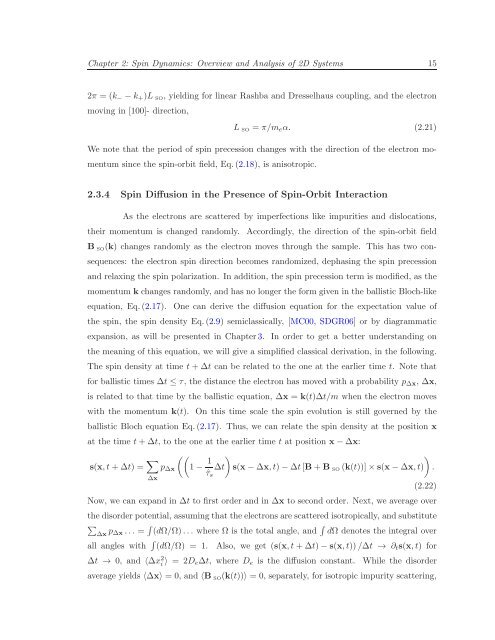Itinerant Spin Dynamics in Structures of ... - Jacobs University
Itinerant Spin Dynamics in Structures of ... - Jacobs University
Itinerant Spin Dynamics in Structures of ... - Jacobs University
Create successful ePaper yourself
Turn your PDF publications into a flip-book with our unique Google optimized e-Paper software.
Chapter 2: <strong>Sp<strong>in</strong></strong> <strong>Dynamics</strong>: Overview and Analysis <strong>of</strong> 2D Systems 15<br />
2π = (k − −k + )L SO , yield<strong>in</strong>g for l<strong>in</strong>ear Rashba and Dresselhaus coupl<strong>in</strong>g, and the electron<br />
mov<strong>in</strong>g <strong>in</strong> [100]- direction,<br />
L SO = π/m e α. (2.21)<br />
We note that the period <strong>of</strong> sp<strong>in</strong> precession changes with the direction <strong>of</strong> the electron momentum<br />
s<strong>in</strong>ce the sp<strong>in</strong>-orbit field, Eq.(2.18), is anisotropic.<br />
2.3.4 <strong>Sp<strong>in</strong></strong> Diffusion <strong>in</strong> the Presence <strong>of</strong> <strong>Sp<strong>in</strong></strong>-Orbit Interaction<br />
As the electrons are scattered by imperfections like impurities and dislocations,<br />
their momentum is changed randomly. Accord<strong>in</strong>gly, the direction <strong>of</strong> the sp<strong>in</strong>-orbit field<br />
B SO (k) changes randomly as the electron moves through the sample. This has two consequences:<br />
the electron sp<strong>in</strong> direction becomes randomized, dephas<strong>in</strong>g the sp<strong>in</strong> precession<br />
and relax<strong>in</strong>g the sp<strong>in</strong> polarization. In addition, the sp<strong>in</strong> precession term is modified, as the<br />
momentum k changes randomly, and has no longer the form given <strong>in</strong> the ballistic Bloch-like<br />
equation, Eq.(2.17). One can derive the diffusion equation for the expectation value <strong>of</strong><br />
the sp<strong>in</strong>, the sp<strong>in</strong> density Eq.(2.9) semiclassically, [MC00, SDGR06] or by diagrammatic<br />
expansion, as will be presented <strong>in</strong> Chapter3. In order to get a better understand<strong>in</strong>g on<br />
the mean<strong>in</strong>g <strong>of</strong> this equation, we will give a simplified classical derivation, <strong>in</strong> the follow<strong>in</strong>g.<br />
The sp<strong>in</strong> density at time t+∆t can be related to the one at the earlier time t. Note that<br />
for ballistic times ∆t ≤ τ, the distance the electron has moved with a probability p ∆x , ∆x,<br />
is related to that time by the ballistic equation, ∆x = k(t)∆t/m when the electron moves<br />
with the momentum k(t). On this time scale the sp<strong>in</strong> evolution is still governed by the<br />
ballistic Bloch equation Eq.(2.17). Thus, we can relate the sp<strong>in</strong> density at the position x<br />
at the time t+∆t, to the one at the earlier time t at position x−∆x:<br />
s(x,t+∆t) = ∑ ∆x<br />
p ∆x<br />
((1− 1ˆτ )<br />
)<br />
∆t s(x−∆x,t)−∆t[B+B SO (k(t))]×s(x−∆x,t) .<br />
s<br />
(2.22)<br />
Now, we can expand <strong>in</strong> ∆t to first order and <strong>in</strong> ∆x to second order. Next, we average over<br />
thedisorderpotential, assum<strong>in</strong>gthat theelectrons arescattered isotropically, andsubstitute<br />
∑<br />
∆x p ∆x... = ∫ (dΩ/Ω)... where Ω is the total angle, and ∫ dΩ denotes the <strong>in</strong>tegral over<br />
all angles with ∫ (dΩ/Ω) = 1. Also, we get (s(x,t+∆t)−s(x,t))/∆t → ∂ t s(x,t) for<br />
∆t → 0, and 〈∆x 2 i 〉 = 2D e∆t, where D e is the diffusion constant. While the disorder<br />
average yields 〈∆x〉 = 0, and 〈B SO (k(t))〉 = 0, separately, for isotropic impurity scatter<strong>in</strong>g,
















